7 ways to fix Windows not detecting microphone error
Some of the more obvious reasons for this include a malfunctioning port or microphone. Errors can also occur due to driver problems or Windows interfering with the microphone's driver. Here are some quick fixes to help you reconnect with your friends if you're having the same problem.
1. Check the microphone and computer ports
To rule out the possibility of a hardware problem with the microphone, you should have the hardware checked first. If your microphone is fine, your computer's audio port may have worn down over time and no longer function properly.
To find out if the cause is hardware related:
- Check the microphone cord for any damage, especially at the ends where it connects to the PC.
- Plug the microphone into any other device (if any) to check if it works.
- Check the connector for bent or burnt.
- Check if any other devices (if any) work on the same computer port.
If the microphone cable is in good condition but does not connect to another device, it means there may be a problem with the microphone. This should be checked by a technician.
If there is no damage to the microphone jack and cord, and the microphone works properly with other systems, and your computer does not respond to other devices connected to the same port, then there is a problem with the computer port.
If no hardware problems are taking place and the microphone is still not being detected by the computer, you may want to disconnect all other devices that are simultaneously connected to the PC.
2. Disconnect all other devices
Disconnecting other devices can eliminate any interference with the microphone's connection. Try plugging in the microphone again after disconnecting all other devices to see if your PC recognizes the microphone this time. If not, the problem lies elsewhere.
3. Change default audio device
Sometimes, your PC will have a default audio input device in its settings. If this happens, your PC will use that device to record audio instead of the microphone. This means that Windows will only listen to the device that is set as default, even if a microphone is plugged in.
Follow these steps to change the default audio device:
- Go to the Windows Settings app.
- Navigate to System settings from the list of options.
- Click Sound in the menu on the left sidebar.
- Open the Input devices drop-down menu and select the microphone.

Note: These steps apply to Windows 10. Other versions of Windows may display slightly differently.
4. Microphone activation has been disabled
If setting the default audio device to microphone doesn't help your device, it's likely you've disabled it in the past. If you disable the microphone, Windows will not allow you to use the microphone when you plug in the device.
To check if this is the case, follow the steps below to enable the microphone:
- Open the Settings app.
- Navigate to System settings and click Sound on the left.
- Next, click Manage sound devices under the Troubleshoot button in Input devices settings.
- Scroll down, find your device under Disabled and enable the microphone by clicking Enable.
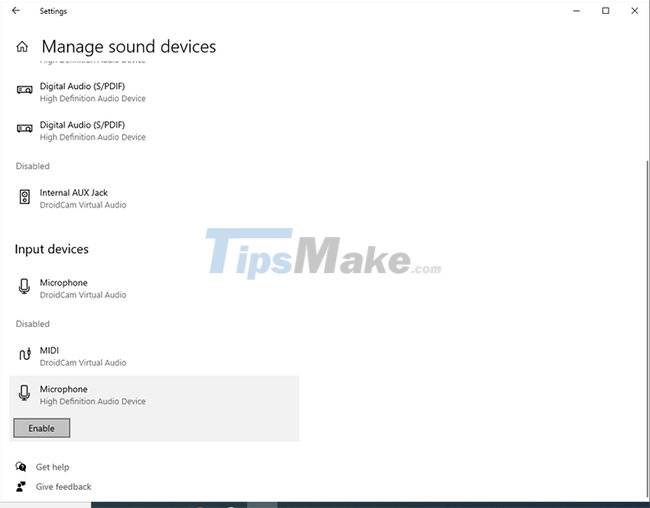
Note: You can do the same thing through the Control Panel if using an older version of Windows.
5. Update micro . driver
If you have a brand new microphone with outdated or no drivers, that can mess up the way the microphone works. This can happen if you disable automatic driver download from Windows, which means your microphone won't receive the latest updates.
In addition, your older OS version is no longer supported, resulting in no microphones being detected. Therefore, it is also necessary to exclude this possibility. To make sure your microphone driver is up to date, follow these steps:
- Go to the Windows desktop and right-click This PC.
- In the menu, select Manage.
- In the Computer Management window, click Device Manager on the left sidebar.
- Expand the Audio inputs and outputs category.
- Find your microphone from the device list.
- Right click on your microphone and select Update driver.
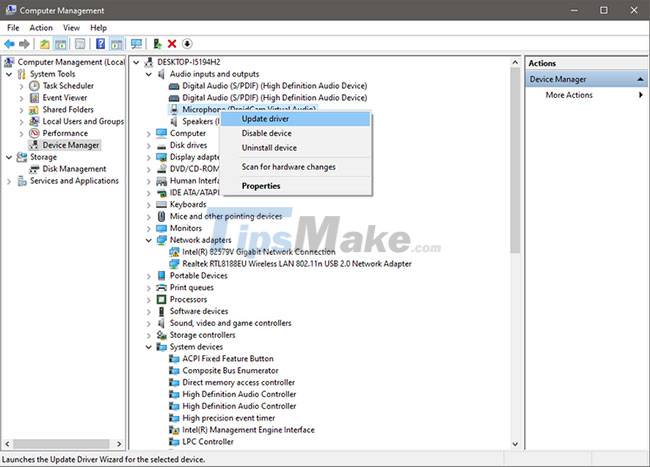
Click Search automatically for drivers in the new pop-up window. It will automatically search for any available updated micro drivers and install them for you.
Assuming you have downloaded the drivers from the manufacturer's website. In that case, you can install them manually by clicking the second option in the pop-up window that says Browse my computer for drivers.
6. Check App Permissions
Sometimes your microphone doesn't work because it doesn't have the right permissions. Maybe you intentionally removed permissions for your microphone and forgot to turn it back on, or a program might have changed your app permissions without your knowledge.
If that's the case, giving the microphone permission to work will immediately fix the problem. You can change your microphone access by following these steps:
- Click the Windows icon in the lower left corner of the taskbar and click Settings.
- Navigate to Privacy settings.
- Locate Microphone in the left sidebar under App permissions.
- Check if the microphone access for this device is On or Off.
- Toggle the switch to the right to turn it back on if it's already off.
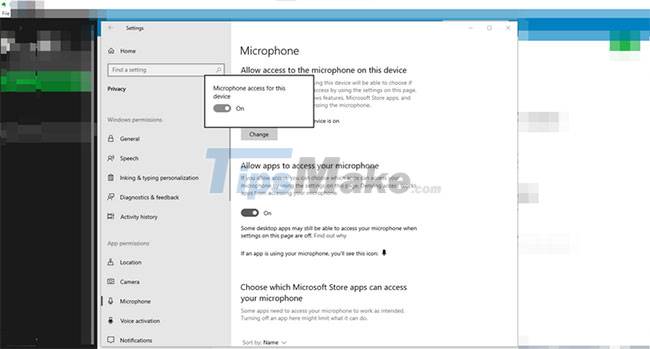
If changing permissions doesn't solve the problem, you can run the Speech Troubleshooter as a last resort to fix the microphone.
7. Run Speech Troubleshooter
Using the Speech Troubleshooter will allow your operating system to diagnose the connection between the computer and the microphone. Automated diagnostic testing often detects hidden connection problems that cannot be resolved by traditional methods.
To find and run the debugger, follow these steps:
- Click the Windows icon in the lower left corner of the taskbar and click Settings.
- Locate Time & Language and open the settings.
- Select Speech from the menu in the left sidebar.
- Under Microphone, click the Get started button.
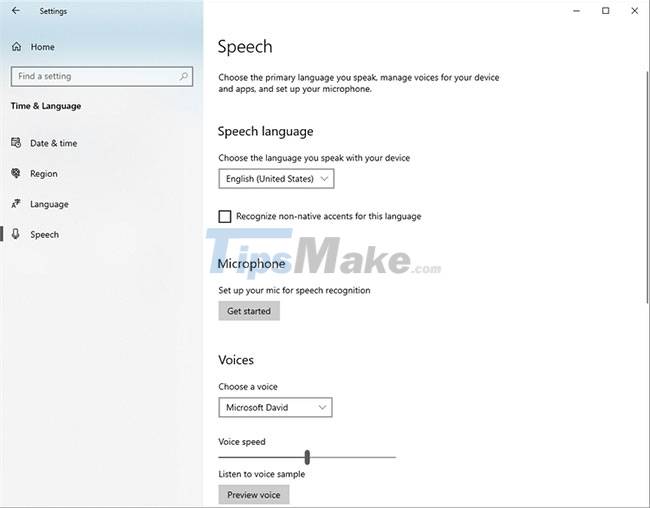
This will open a new window with some troubleshooting options. Select Cortana can't hear me. Select the device (microphone) you want to troubleshoot. Click Next after selecting the device.
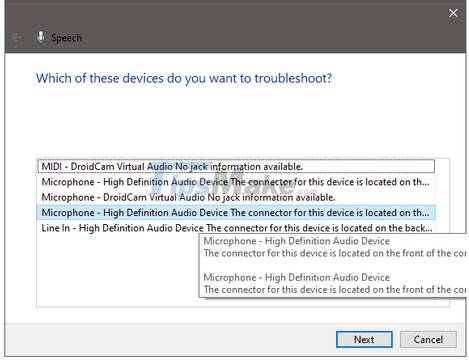
The troubleshooter will then proceed to detect issues and, when they are identified, select and implement the recommended action. Even if nothing else works, hopefully, this step will help you get your microphone working again.
You should read it
- How to test the Windows 10 microphone
- How to enable microphone in Windows 10
- Steps to install microphone on Windows 10
- Instructions for setting up and installing Microphone on computer
- How to choose default microphone on Windows 10
- How to Adjust Microphone Sensitivity on Android, iOS, Mac and Windows
- Instructions for checking Microphone, Headphone on Windows 7
- Fix the error of inactive microphones in Windows 10
May be interested
- Steps to install microphone on Windows 10
 to voice chat or give commands to the computer, you need to connect the microphone recording device to the computer. to set up microphone for windows 10 we need to do the following:
to voice chat or give commands to the computer, you need to connect the microphone recording device to the computer. to set up microphone for windows 10 we need to do the following: - Fix the error of inactive microphones in Windows 10
 perhaps there is no need to talk about the importance of microphones on a pc on a computer.
perhaps there is no need to talk about the importance of microphones on a pc on a computer. - 7 ways to fix Windows error not detecting graphics card
 have you recently bought a new graphics card but your pc doesn't detect it? or has your system suddenly stopped detecting a card you've been using for a while?
have you recently bought a new graphics card but your pc doesn't detect it? or has your system suddenly stopped detecting a card you've been using for a while? - Instructions for setting up and installing Microphone on computer
 when setting up connecting a microphone to a windows computer, we can easily record our voice, even sing karaoke easily without using other expensive devices.
when setting up connecting a microphone to a windows computer, we can easily record our voice, even sing karaoke easily without using other expensive devices. - How to choose default microphone on Windows 10
 today, windows 10 users often need to combine multiple microphones - maybe one built in on a pc, one on the webcam, on a headset, and possibly a podcast microphone too.
today, windows 10 users often need to combine multiple microphones - maybe one built in on a pc, one on the webcam, on a headset, and possibly a podcast microphone too. - 6 ways to fix Bluetooth errors not in Device Manager on Windows 10, 8.1, 8, 7, XP, Vista
 cannot connect a bluetooth device to a computer? bluetooth keyboard, mouse, microphone, headset or other wireless devices are not recognized in windows computers, this is a bluethooth error not available in device manager on windows. therefore, this article will introduce you to 6 ways to fix this bluetooth error on windows.
cannot connect a bluetooth device to a computer? bluetooth keyboard, mouse, microphone, headset or other wireless devices are not recognized in windows computers, this is a bluethooth error not available in device manager on windows. therefore, this article will introduce you to 6 ways to fix this bluetooth error on windows. - How to Adjust Microphone Sensitivity on Android, iOS, Mac and Windows
 when your microphone isn't set up properly, it can cause your speech-to-text software to misbehave and cause tiresome voice calls.
when your microphone isn't set up properly, it can cause your speech-to-text software to misbehave and cause tiresome voice calls. - Steps to fix Windows 10 can't connect headphones
 most home setups require the user to use a headset to make zoom and google meet calls seamless. gamers and music enthusiasts alike opt for headphones to get through a long day.
most home setups require the user to use a headset to make zoom and google meet calls seamless. gamers and music enthusiasts alike opt for headphones to get through a long day. - Instructions for checking Microphone, Headphone on Windows 7
 microphone and headphone are very familiar devices when we use computers. so how can we know that they work well on computers?
microphone and headphone are very familiar devices when we use computers. so how can we know that they work well on computers? - How to fix a noisy microphone quickly and in detail
 your laptop microphone is currently distorted, the sound is not clear. so how to fix the microphone distortion?
your laptop microphone is currently distorted, the sound is not clear. so how to fix the microphone distortion?










 How to fix 'Base System Device' error in Device Manager
How to fix 'Base System Device' error in Device Manager How to fix Dxgmms2.sys xanh Blue Screen error
How to fix Dxgmms2.sys xanh Blue Screen error Steps to Fix Mobile Hotspot not working on Windows 10
Steps to Fix Mobile Hotspot not working on Windows 10 What to do when the Windows Taskbar is frozen, unusable?
What to do when the Windows Taskbar is frozen, unusable? How to fix error 0x800704C8 when Copying files on the computer
How to fix error 0x800704C8 when Copying files on the computer 9 Simplest Ways to Fix Computer Not Receiving Mouse Error
9 Simplest Ways to Fix Computer Not Receiving Mouse Error